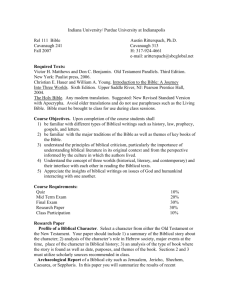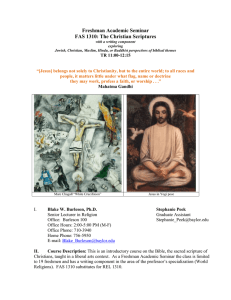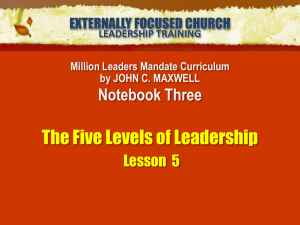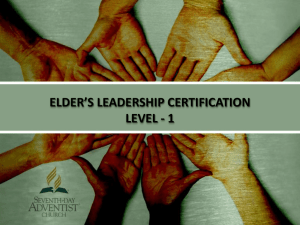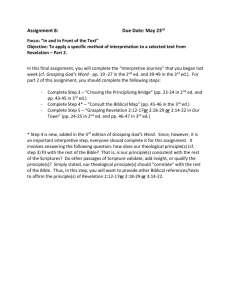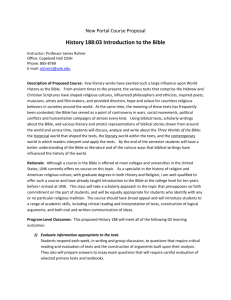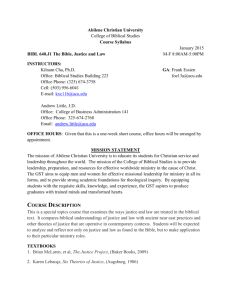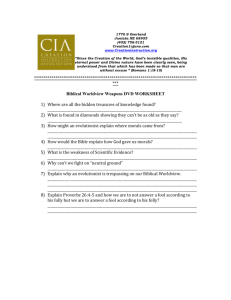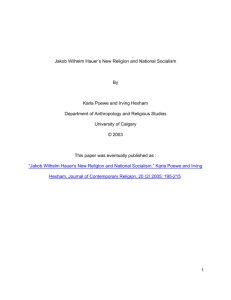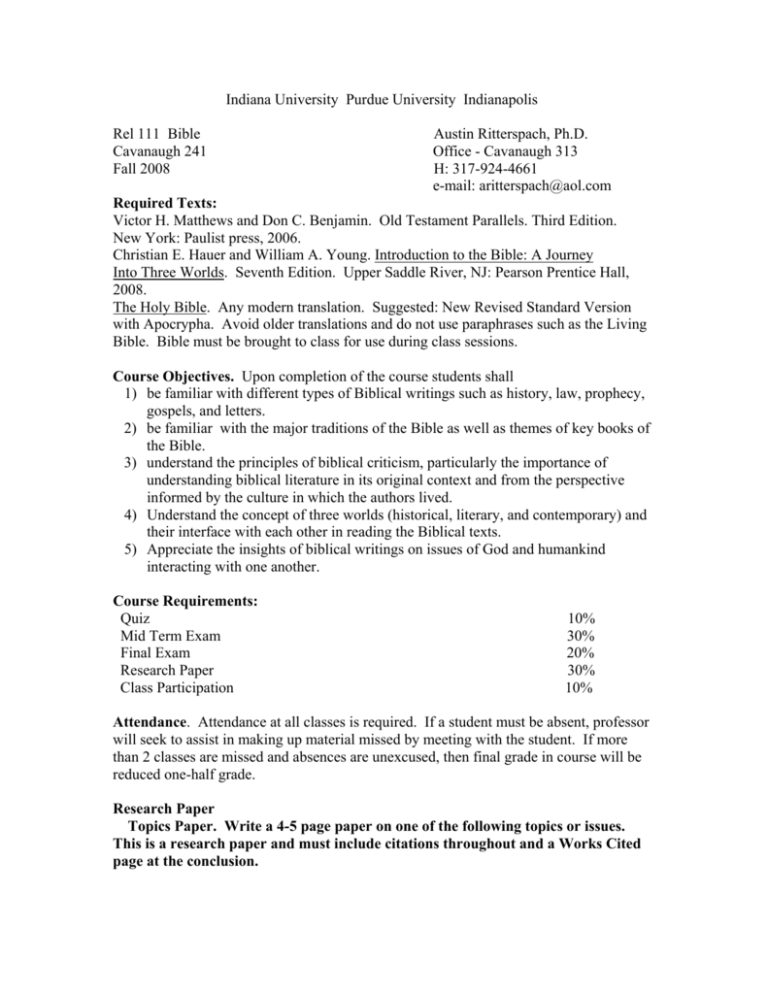
Indiana University Purdue University Indianapolis
Rel 111 Bible
Cavanaugh 241
Fall 2008
Austin Ritterspach, Ph.D.
Office - Cavanaugh 313
H: 317-924-4661
e-mail: aritterspach@aol.com
Required Texts:
Victor H. Matthews and Don C. Benjamin. Old Testament Parallels. Third Edition.
New York: Paulist press, 2006.
Christian E. Hauer and William A. Young. Introduction to the Bible: A Journey
Into Three Worlds. Seventh Edition. Upper Saddle River, NJ: Pearson Prentice Hall,
2008.
The Holy Bible. Any modern translation. Suggested: New Revised Standard Version
with Apocrypha. Avoid older translations and do not use paraphrases such as the Living
Bible. Bible must be brought to class for use during class sessions.
Course Objectives. Upon completion of the course students shall
1) be familiar with different types of Biblical writings such as history, law, prophecy,
gospels, and letters.
2) be familiar with the major traditions of the Bible as well as themes of key books of
the Bible.
3) understand the principles of biblical criticism, particularly the importance of
understanding biblical literature in its original context and from the perspective
informed by the culture in which the authors lived.
4) Understand the concept of three worlds (historical, literary, and contemporary) and
their interface with each other in reading the Biblical texts.
5) Appreciate the insights of biblical writings on issues of God and humankind
interacting with one another.
Course Requirements:
Quiz
Mid Term Exam
Final Exam
Research Paper
Class Participation
10%
30%
20%
30%
10%
Attendance. Attendance at all classes is required. If a student must be absent, professor
will seek to assist in making up material missed by meeting with the student. If more
than 2 classes are missed and absences are unexcused, then final grade in course will be
reduced one-half grade.
Research Paper
Topics Paper. Write a 4-5 page paper on one of the following topics or issues.
This is a research paper and must include citations throughout and a Works Cited
page at the conclusion.
1. Describe the dimensions of Solomon’s temple, the layout of the temple, and the
structures in front of it. How does it compare with the temple at Ain Dara? What is
the Ark of the Covenant?
2. Isaiah 7:1-15. Explain the background or setting of this prophecy and give 2
theories about what the sign means including the argument of Biblical scholars.
3. Review Gen. 18, the story of Sodom and Gomorrah and discuss 1) an interpretation
of this passage arguing that it condemns homosexuality and 2) an interpretation of
this passage that conludes that it has nothing to do with homosexuality. What do
you think?
4. Discuss I Corinthians 15 and describe Paul’s view of 1)the kerygma, and 2) the
resurrection of the dead. Would Paul agree with the empty tomb stories in the
gospels?
Course Outline
I. Methods of Biblical Study. Geography of Israel and the Ancient
Near East. Organization of the Bible
Matt. 7:12
Gen. 2:4-3:24
Hauer and Young, pp. 1-64 (see maps on pp. 22-23.
Aug.20,
27
II. Major Biblical Traditions: the Ancestors, the Exodus.
Sept. 3
Gen. 12:1- 9; 28:1-17; 32:22-32. Ex. 1-3; 20:1-17. Deut. 26:5-10..
Hauer, pp. 76-87, 93-107. .
Arnold, pp. 72-73 (“Adoption of Shennima”), pp. 111-113 (“Law Code of
Hammurapi”) (reserve).
QUIZ
Sept. 10
III. Covenant at Mt. Sinai. Settlement in Canaan.
Sept. 10
Jos. 6. Jos. 24. Judges 4-5. (settlement)
I Sam. 10:1-17 II Sam. II. Sam 6:12-23. 7:1-14. I Kings 6-7. (united monarchy.)
Hauer, pp. 109-119..
Matthews and Benjamin, pp. 97-98. (“Annals of Merneptah”)
IV.
Formation of the State of Israel. Covenant Advocates: the Prophets
Sept. 17
of Ancient Israel.
I Sam. 10:1-17. II Sam. 6:12-23. 7:1-14. I Kings 6-7 (united monarchy).
I Kings 21-22; II Kings 17:7-41. Amos 6:1-7; 7:1-17. Book of Hosea.
Jer. 7; 26:1-19; 31:31-34. Is. 7:1-25.
Hauer, pp. 120-146.
Matthews and Benjamin, pp. 170-71, 193. (“Tel Dan Annals” and “Siloam
Story”).
V.. Torah: Book of Beginnings. Creation and Flood
Sept. 24
Hauer, pp. 67-78.. Matthews and Benjamin, “Stories of Gilgamesh,” pp. 21-32
Arnold, pp. 15-19. “Enki and Ninhursag” (reserve)
Num. 6:24-26 Gen. 1:1-3:24. Gen. 6-9.
VI. Fall of Judah. Prophets of the Exile.
Oct. 1
Isaiah 40:1-45:7. Ezekiel 1-7; 40-48.
Hauer, pp. 147-61, 197-202.
Eilat Mazar, “Did I Find King David’s Palace?” Biblical Archaeology Review
January-February 2006 (reserve)..
Mid-Term Exam
Oct. 8
VII. Sacred Songs and Philosophical Wisdom.
Oct. 15
Hauer, pp. 163-96.
Book of Job. Eccl. 1-3; 7. Psalms 1,2, 23, 24, 117, 150.
Matthews and Benjamin, pp. 239-44 (“A Sufferer and a Friend in Babylon”).
VIII. Between the Testaments: Dead Sea Scrolls and Apocalyptic Literature Oct. 22
Book of Daniel. Hauer, pp. 206-236.
James Vanderkam, The Meaning of the Dead Sea Scrolls, pp. (reserve)
IX.. The Proclaimer and the Proclaimed: Jesus and the Gospel Writers
Oct. 29
Hauer, pp. 239-59.
Determining What Jesus Actually Said: Matt. 1-3; 16:13-20. Luke 4:16-30.
Lk. 15 (Parables. Lk. 11:2-4. Mt. 6:9-13 (Lord’s Prayer).
Lk. 6:20-26 and Mt. 5:3-12 (Blessings).
X. Unique Theology of a Gospel Writer: Mt. 21:1-11. Zechariah 9:9,
Mt. 27-28 Luke 6:20-26. Lk. 11:2-4. John 14-15.
Hauer, pp. 262-88.
Nov. 5
Research Paper
XI. Birth of Christianity; The Acts of the Apostles
Hauer, pp. 289-304.
Acts 2; 9:1-30.
Nov. 12
Nov. 12 .
XII. Paul Writes to the Early Church
Hauer, pp. 307-328
I Corinthians. Galatians.
THANKSGIVING
Nov. 19
XIII. Later literature and non-canonical books.
Revelation.
I, II Timothy Gospel of Mary (reserve), pp. 3-47, 69-81.
Hauer, pp. 329-47.
Final Exam
Nov. 26-30
Dec. 3
Dec. 10.
“Of the making of many books there is no end, and much study is a weariness of the
flesh.”

